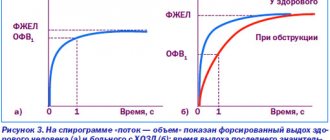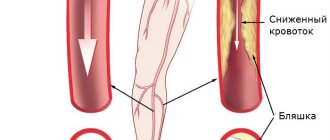29.05.2017 0
12352
The feet are burning or there is a burning sensation in the feet - a sensation that causes discomfort. You want to quickly get rid of your shoes, cool off, or scratch your foot. Among the reasons for this feeling are various disorders or even illnesses. It is important to correctly understand the symptoms and, based on them, organize treatment: either with folk remedies or with pharmaceuticals.
Causes of burning
Why does this symptom occur? The reason can be very simple - mechanical impact. For example, wearing uncomfortable shoes or tight clothing can lead to a feeling of heaviness, soreness and burning not only in the feet, but throughout the entire leg. There is no need to treat this condition; it is enough to simply purchase comfortable shoes in which your feet will not get so tired by the end of the working day.
Why do my legs burn below the knees? Another reason is allergies. Skin reactions may occur due to exposure to allergens. There is a burning sensation, rash or itching. The following factors may irritate you:
- synthetic fabric - stockings or socks;
- insole material;
- low-quality foot cosmetics;
- aggressive foot treatments;
- poor quality shoes.
Allergies require specific treatment. Eliminating the allergen is usually sufficient. Sometimes it is also necessary to use antihistamines. But they must be prescribed by a specialist. No other treatment is required once the allergy symptoms go away and the burning sensation in the feet and legs, as well as the itching and redness, disappear.
Fungal diseases can also cause burning. Fungus can develop on the skin of the foot or nails and this leads to itching and burning not only on the foot itself, but also below the knee. In case of fungal infections, external agents - gels, ointments - will help. Therapy is usually long-term, but with proper treatment, complete recovery can be achieved.
But the causes of burning in the leg below the knee can be more serious. These can be certain diseases and their list is quite large. Here are the main reasons:
- osteochondrosis;
- injuries;
- tumors;
- kidney disease;
- vascular pathology;
- lack of vitamins and minerals;
- neuropathy;
- hypothyroidism;
- knee diseases;
- hypertension;
- heavy metal poisoning;
- taking certain medications.
The most common cause is vascular disorders. All organs and systems are provided with valuable substances and oxygen. If vascular disorders occur, the muscles and tissues do not receive enough nutrition. This leads to symptoms such as burning and cramping. Therefore, if your legs are burning and there are symptoms of vascular disorders, certain treatment is necessary.
What vascular diseases can cause these symptoms? These include:
- Thrombophlebitis is inflammation of the walls of blood vessels with sedimentation of blood clots.
- Varicose veins are lengthening and expansion of veins in the lower extremities.
- Atherosclerosis of the legs - blood vessels become clogged and normal blood flow is disrupted.
- Obliterating endarteritis is an infection of the arteries.
A burning sensation in the legs below the knee can occur with neuropathies. The cause may be diabetes. In addition, other endocrine diseases are possible. In these diseases, the lower extremities are first affected, and then other parts of the nervous system. In addition to burning, pain, numbness, and a tingling sensation may be bothersome.
Fact! With endocrine diseases, “pins and needles” may also bother you.
Limb injuries can cause pain and burning below or above the knee. Injuries can be anything from bruises to fractures and torn ligaments. With a severe injury, pain occurs immediately, and with a mild injury, by the end of the first day. In addition to pain and burning, the following symptoms may occur:
- swelling;
- abrasions;
- hematomas;
- soreness when palpated;
- restriction of movement;
- leg deformity.
Don't forget about osteochondrosis. This disease can cause not only pain in the spine, but also in the legs. Usually with this disease the legs burn above the knees. However, a burning sensation may also occur below the knees, since the manifestations are individual. This disease can be suspected by pain from the back to the foot, muscle weakness. In addition, with osteochondrosis, sensitivity may decrease and the process of walking may be disrupted.
These are the most common causes of burning in the sole, joint or below the knees. But there may be other diseases or conditions that cause a similar symptom.
For example, pregnancy. This, of course, is not a disease, but if you feel a burning sensation in your legs, you need to see a doctor to get rid of this symptom. A burning sensation during pregnancy may occur because there is not enough blood flowing to the muscles.
What pathological processes are indicated by burning sensations in the legs?
A burning sensation can be diagnosed:
- For diabetes mellitus.
- For varicose veins of the lower extremities.
- For fungal infections of the feet.
- For prostatitis or inflammation of the prostate gland.
- For diseases of the spinal column - osteochondrosis.
- For vegetative-vascular dystonia (VSD).
- With neurosis.
- With hereditary predisposition.
- During pregnancy.
Diabetes
Diabetes mellitus is characterized by the symptom of diabetic neuropathy, which occurs due to damage to the vessels of the capillary network. Their defeat leads to the fact that the nerve endings begin to have poor blood supply. As a result, the patient experiences a feeling of crawling, tingling and burning sensations in the legs. If you press on your toes, pain reflexively occurs, spreading from the foot and above.
Phlebeurysm
With varicose veins, in addition to burning, there are other symptoms: swelling of the lower extremities, which manifests itself towards the end of the day, spider veins, muscle cramps, which often appear at night. Either pain or a feeling of fullness appears in the calves of the legs.
Fungus - what does it mean?
If a fungus appears, then the clinical picture has the following characteristics:
- A burning and itching sensation appears at the site of the fungus.
- Symptoms are present throughout the day.
- The disease does not go away on its own. If antifungal therapy is not started in a timely manner, the clinical picture becomes clearer.
For prostatitis
If a man has a history of prostatitis, then the following manifestations are possible:
- Aching pain appears in the projection of the inner thigh. In this case, patients report a feeling of squeezing of blood vessels.
- There is a burning sensation and shooting sensations in the legs below the knee, as if they were burning with fire.
- The pain symptom is not always present. It appears spontaneously and goes away on its own.
For osteochondrosis
The disease osteochondrosis is characterized by pain in the lumbar region, gradually the pain begins to spread towards the hips and calf muscles. Usually only one of the lower extremities is involved in the pathological process. In addition to pain, there is lameness, muscle cramps, weakness in the legs and numbness in the lower half of the body. During movement, tingling and burning sensations appear above the knee.
Vegetative-vascular dystonia
VSD is characterized by burning sensations of different localization (in the legs, torso, upper extremities, legs), but most often it is observed in the legs. With this disease, patients note increased weakness, fatigue, and problems sleeping. They are thrown either hot or cold. The sweat glands work more actively than usual, which leads to increased sweating. Hands and feet with VSD are always cold.
Neurosis
With neurosis, pain most often appears in the joints of the lower extremities. Such patients step on their feet with caution, because there is a feeling of paralysis of the legs. Their gait is uncertain and shaky. They cannot walk or even stand for a long time. Symptoms usually appear in the tissue below the knee and are characterized by numbness, squeezing and a stinging sensation as if stung by nettles.
In pregnant women
During pregnancy, not everyone experiences a burning sensation in their legs. This is usually a manifestation of gestosis (complication) in late pregnancy. Because the disease is characterized by severe swelling and increased pressure, compression of blood vessels occurs and deterioration of blood supply to the tissues of the lower extremities. This leads to pain and burning.
How is diagnosis carried out?
Finding the cause of heat in the joint itself and below it helps not only the doctor’s conversation with the patient and palpation of the limbs, but also other additional methods. What does a specialist usually prescribe?
Here are the main research methods:
- Ultrasound of vessels and tissues;
- Analysis of urine;
- X-ray;
- blood biochemistry;
- neuromyography;
- tomography. CT or MRI.
Specific studies are prescribed by the doctor depending on other symptoms.
A burning sensation alone is not enough to make an accurate diagnosis. If the doctor prescribes some kind of examination, you should not refuse. The more information there is, the more accurate the diagnosis will be.
Treatment for burning
Of course, treatment will depend on whether the burning sensation is below or above the knee, as well as on a host of other nuances. The main thing is to make the correct diagnosis and find the cause of the disturbing symptom. The choice of a specific treatment depends on many characteristics (age, concomitant diseases of the patient), as well as on the specific decision of the doctor, who is guided by his experience.
Important! When visiting a doctor, it is advisable to choose the most qualified and experienced specialist.
Therefore, drugs are prescribed based on the main reason. Usually prescribed:
- strengthening vitamins;
- vascular drugs;
- anti-inflammatory drugs;
- ventonics;
- antiplatelet agents;
- antioxidants;
- muscle relaxants;
- knee blocks with anesthetics or hormones.
Causes of burning
Why does this symptom occur? The reason can be very simple - mechanical impact. For example, wearing uncomfortable shoes or tight clothing can lead to a feeling of heaviness, soreness and burning not only in the feet, but throughout the entire leg. There is no need to treat this condition; it is enough to simply purchase comfortable shoes in which your feet will not get so tired by the end of the working day.
Why do my legs burn below the knees? Another reason is allergies. Skin reactions may occur due to exposure to allergens. There is a burning sensation, rash or itching. The following factors may irritate you:
- synthetic fabric - stockings or socks;
- insole material;
- low-quality foot cosmetics;
- aggressive foot treatments;
- poor quality shoes.
Allergies require specific treatment. Eliminating the allergen is usually sufficient. Sometimes it is also necessary to use antihistamines. But they must be prescribed by a specialist. No other treatment is required once the allergy symptoms go away and the burning sensation in the feet and legs, as well as the itching and redness, disappear.
Fungal diseases can also cause burning. Fungus can develop on the skin of the foot or nails and this leads to itching and burning not only on the foot itself, but also below the knee. In case of fungal infections, external agents - gels, ointments - will help. Therapy is usually long-term, but with proper treatment, complete recovery can be achieved.
But the causes of burning in the leg below the knee can be more serious. These can be certain diseases and their list is quite large. Here are the main reasons:
- osteochondrosis;
- injuries;
- tumors;
- kidney disease;
- vascular pathology;
- lack of vitamins and minerals;
- neuropathy;
- hypothyroidism;
- knee diseases;
- hypertension;
- heavy metal poisoning;
- taking certain medications.
The most common cause is vascular disorders. All organs and systems are provided with valuable substances and oxygen. If vascular disorders occur, the muscles and tissues do not receive enough nutrition. This leads to symptoms such as burning and cramping. Therefore, if your legs are burning and there are symptoms of vascular disorders, certain treatment is necessary.
What vascular diseases can cause these symptoms? These include:
- Thrombophlebitis is inflammation of the walls of blood vessels with sedimentation of blood clots.
- Varicose veins are lengthening and expansion of veins in the lower extremities.
- Atherosclerosis of the legs - blood vessels become clogged and normal blood flow is disrupted.
- Obliterating endarteritis is an infection of the arteries.
A burning sensation in the legs below the knee can occur with neuropathies. The cause may be diabetes. In addition, other endocrine diseases are possible. In these diseases, the lower extremities are first affected, and then other parts of the nervous system. In addition to burning, pain, numbness, and a tingling sensation may be bothersome.
Fact! With endocrine diseases, “pins and needles” may also bother you.
Limb injuries can cause pain and burning below or above the knee. Injuries can be anything from bruises to fractures and torn ligaments. With a severe injury, pain occurs immediately, and with a mild injury, by the end of the first day. In addition to pain and burning, the following symptoms may occur:
- swelling;
- abrasions;
- hematomas;
- soreness when palpated;
- restriction of movement;
- leg deformity.
What disease causes burning feet?
The reasons why a burning sensation occurs in the feet are quite varied.
Allergic reaction
An allergic reaction to the materials from which clothing or shoes are made. Synthetics, dyes, and additives for treating shoes can cause severe irritation of the skin of the feet, which is manifested, among other things, by severe burning.
Treatment in this situation consists of replacing allergenic clothing or shoes and using local antihistamines.
Fungus
Mycosis . Fungal infection of the skin of the feet is manifested by severe itching and burning on the feet, between the toes. The skin in these places becomes rough, peels, and cracks.
If the foot of only the left leg or only the right one burns, it is likely that we are talking about a fungal infection. To eliminate unpleasant symptoms, you need to get rid of the fungus.
Self-medication does not always bring the desired results; it is necessary to undergo tests, determine the pathogen, and then prepare for a long struggle.
How is diagnosis carried out?
Finding the cause of heat in the joint itself and below it helps not only the doctor’s conversation with the patient and palpation of the limbs, but also other additional methods. What does a specialist usually prescribe?
Here are the main research methods:
- Ultrasound of vessels and tissues;
- Analysis of urine;
- X-ray;
- blood biochemistry;
- neuromyography;
- tomography. CT or MRI.
Specific studies are prescribed by the doctor depending on other symptoms.
A burning sensation alone is not enough to make an accurate diagnosis. If the doctor prescribes some kind of examination, you should not refuse. The more information there is, the more accurate the diagnosis will be.
Treatment for burning
Of course, treatment will depend on whether the burning sensation is below or above the knee, as well as on a host of other nuances. The main thing is to make the correct diagnosis and find the cause of the disturbing symptom. The choice of a specific treatment depends on many characteristics (age, concomitant diseases of the patient), as well as on the specific decision of the doctor, who is guided by his experience.
Important! When visiting a doctor, it is advisable to choose the most qualified and experienced specialist.
Therefore, drugs are prescribed based on the main reason. Usually prescribed:
- strengthening vitamins;
- vascular drugs;
- anti-inflammatory drugs;
- ventonics;
- antiplatelet agents;
- antioxidants;
- muscle relaxants;
- knee blocks with anesthetics or hormones.
Physiotherapeutic procedures are often used. They improve blood circulation, relieve pain and help relieve burning sensation. The doctor may prescribe one or more procedures. The most effective procedures include:
- magnetic therapy;
- cryotherapy;
- laser treatment;
- electrophoresis;
- hydrotherapy;
- mud therapy;
- UHF therapy;
- reflexology.
It is impossible to solve joint problems without therapeutic exercises. Therefore, exercise therapy is always prescribed during treatment. Gymnastics helps restore mobility in the legs, improve nutrition and blood circulation in joints and tissues. In addition, a specialist often prescribes a massage. It normalizes muscle tone and also improves blood flow in tissues. Usually both methods of treatment are prescribed, this helps to cope with the disease faster.
Usually, you can get rid of the feeling of heat in the legs and feet during pregnancy with the help of diuretics. Since it is fluid retention in the body that causes a burning sensation. Pregnant women do not require any other treatment, especially since strong drugs can harm the unborn child.
A burning sensation in the legs below or above the knees or in the feet is a dangerous symptom that can indicate many diseases. This symptom should not be ignored, because lack of treatment can lead to serious health problems.
We will be very grateful if you rate it and share it on social networks
The main reasons why your feet burn
The soles of your feet burn for a variety of reasons. The most common of them are varicose veins, thrombophlebitis, and atherosclerosis.
- It is vascular damage that is often responsible for the fact that at the end of the day the legs “hum” and there is a burning sensation on the soles of the feet. Many patients who have problems with veins complain of pain and swelling in the feet; spider veins and a network of small vessels can form on the legs. When exercising, walking quickly, or doing work that requires standing on your feet for a long time, you are often bothered by an unpleasant burning sensation in your feet.
- A pathology such as atherosclerosis is also characterized by problems with blood vessels, blood clots, burning sensations in the feet, and leg cramps occur, which can start from the lower leg and rise higher to the buttocks.
- Fungal infection of the lower extremities. Foot fungus most often finds its favorite spot between the toes. Actively multiplying, the fungus gradually takes over the entire foot. The skin begins to peel, the feet itch and burn; to cure this pathology, you need to visit a dermatologist.
- Diabetes mellitus can also cause burning in the feet. It is known that diabetes mellitus is a disease that has a very negative effect on blood vessels, especially small capillaries. Small vessels that are located in the lower extremities lose their elasticity and die. This process causes blood flow to decrease and the legs to ache and burn.
- Lack of B vitamins. The acute form of vitamin deficiency provokes cramps of the lower extremities and pain in the feet.
- Wearing uncomfortable shoes. Could this problem occur? when shoes are too tight, they compress blood vessels and nerve endings. If you walk in such shoes all day, then burning, pain and swelling of the limbs are guaranteed.
- Pregnancy. In the last months of pregnancy, when the weight of the fetus increases, the load on the woman’s legs increases accordingly. The soles of your feet burn and feel uncomfortable, especially after a long walk. Gynecologists recommend resting with your legs elevated.
- There is such a thing as “vascular play” - this is manifested by the dilation of blood vessels and the feeling that the feet are on fire. The attack usually occurs at the end of the working day.
Causes
When your legs burn below or above the knees, it causes a lot of unpleasant moments and disrupts your normal life.
It is completely understandable that your legs are subject to significant stress throughout the day. They bear the weight of the entire body and must ensure its movement. But, in addition to the musculoskeletal system, other structural components may also suffer, especially in conditions of internal imbalance of metabolic processes. Therefore, the causes of burning are:
- Injuries.
- Neuropathies.
- Vascular pathology.
- Osteochondrosis.
- Diseases of the knee joint.
- Connective tissue diseases.
- Fibromyalgia.
- Deficiency of vitamins and minerals.
- Tumors.
As you can see, the list of possible conditions is quite impressive; it includes serious diseases that require a timely and correct response. To prevent the disease from progressing and start early treatment, you should always consult a doctor.
The causes of burning above or below the knees lie in pathological processes that can affect any structural and functional components of the limbs.
Why there is no urge to defecate: what medications to take, doctors’ recommendations
Burning feet bring a lot of discomfort, and have a medical name that few have heard of - Gopalan syndrome. If the soles of your feet burn, the reasons may lie in completely different factors. Discomfort can be caused by fungus, rubbing and overheating of the skin of the feet, or provoked by more serious pathologies. What to do if your feet burn, and why is it dangerous?
Why do the soles of your feet burn - reasons
Unpleasant sensations on the soles of the feet, a feeling of heaviness, stiffness and pain have many causes and require careful diagnosis and treatment. Typically, elderly people turn to doctors with the complaint of “burning feet.” This is due to the fact that over time, their body’s resistance to various diseases decreases.
In addition, this symptom usually occurs in the afternoon or at night. In this case, unpleasant sensations and pain occur not only in the heel area, but also in the fingers and ankle joint. Therefore, sometimes it seems as if my legs are starting to twist.
According to experts, Gopalan syndrome is not a separate disease. Most often, with a regular burning sensation in the legs, a systemic disease is detected, which usually leads to these symptoms. Thus, irritating factors may not be associated with the legs at all, and the burning sensation is provoked by systemic disorders in the body.
There are many different reasons that cause a burning sensation:
Source: https://wkrasote.ru/zdorovie/lechenie/goryat-podoshvyi-nog-prichinyi.html
Symptoms
Clarification of the symptoms of the disease is a defining moment in clinical diagnosis. This also suggests the reason why the patient’s legs are burning below the knees. Considering burning as one of the signs, you need to pay attention to its features:
- Localization.
- Prevalence.
- Expressiveness.
- Periodicity.
- Duration.
- Dependence on any factors.
Unpleasant sensations in the legs are difficult not to notice, but sometimes they are attributed to banal overexertion and fatigue. But when discomfort begins to bother you constantly, it becomes clear that you can’t do without medical help. The doctor tries to collect all the symptoms into a single picture, taking into account not only the burning sensation in the legs, but also the accompanying symptoms. And depending on the disease, they can be completely different. Therefore, we should take a closer look at the most common conditions in which the legs burn below or above the knees.
Traditional medicine against burning in the feet
For such a symptom, traditional methods of external influence on the stimulus are well suited. Of course, if it is situational and definitely not related to diseases. Traditional medicine recommends medications based on natural remedies that are sold in pharmacies:
Compresses and baths will help eliminate fatigue
- Herbal compresses with a base of hop cones or horsetail. 2 tbsp. l. pour boiling water, wait until the infusion cools to room temperature. Next, wet a piece of cloth and wrap your foot.
- Blue clay foot mask. Apply a thin layer of it to your foot, wrap your foot in plastic and put on socks. The mask should be washed off after a couple of hours with warm, non-soapy water.
- To enhance the effect of lotions and other external remedies, take herbal infusions internally. Flowers and fruits of hawthorn will strengthen and make blood vessels more elastic: 2 tbsp. l. of the ground plant, pour 300 ml of boiling water into a thermos, close the lid and let it brew for several hours. Drink this medicine half an hour before meals, 3 times a day, 100 ml. Pharmacy tincture of hawthorn is taken according to the same schedule, 30 drops at a time.
- An infusion of chestnut flowers is excellent for internal use. 2 tbsp. l. pour into a thermos, pour boiling water over it and wait a few hours. Drink warm several times a day. This infusion is best consumed 1-2 days before, fresh.
Advice. A good prevention of burning in the feet is to exclude certain foods and drinks from the diet. If the symptom occurs regularly, reduce your intake of spicy foods, salt and seasonings, soda and beer. All of them stimulate blood stagnation.
All the described methods of getting rid of unpleasant sensations in the feet are good for primary treatment and only in cases when you are simply tired and not sick. A healthy diet, fresh air, and proper restorative procedures will effectively counteract the burning sensation and the factors that cause it, even if you spend whole days on your feet.
Diagnostics
Additional methods help determine the cause of heat in the lower extremities. Given the multiplicity of possible conditions, various laboratory and instrumental tools are needed. These include:
- Biochemical blood test (glucose, coagulogram, inflammatory markers, rheumatic tests, etc.).
- Radiography.
- Ultrasound of soft tissues and blood vessels.
- Tomography (computer and magnetic resonance imaging).
- Neuromyography.
After receiving the research results, you may need to consult with specialists who will help you formulate the correct treatment tactics.
Treatment
If the legs are burning above, below the knees or the knees are burning, then treatment will depend on the diagnosis. There are various methods that can help such patients. But the choice of one or another remedy should be made only by a doctor, guided by the standards of therapy and his own experience. Concomitant diseases that will likely be identified in the patient are also important. Therefore, treatment must be strictly individual.
Medicines
Treatment of diseases of the lower extremities begins with the use of medications. This is due to the fact that they have a pronounced effect on various parts of the pathological processes that provoke a burning sensation in the legs. Taking into account the origin of painful symptoms, the following drugs are prescribed:
- Non-steroidal anti-inflammatory drugs (Ketorol, Movalis).
- Muscle relaxants (Mydocalm).
- Vitamins (Milgamma, Combilipen).
- Vascular (Trental, Actovegin).
- Antiplatelet agents (Curantil, Cardiomagnyl).
- Venotonics (Detralex, Aescusan).
- Antioxidants (Mexidol, Berlition).
Topical agents – ointments, gels, creams – also play a certain role. In some cases, blockades with hormones and anesthetics may be used.
Medicines should be prescribed by a doctor, determining the required dosage and course of administration.
Physiotherapy
For diseases of the musculoskeletal, nervous and vascular systems, physical methods of treatment are indicated. They help reduce signs of inflammation, improve blood flow in tissues and activate local metabolic processes. Therefore, for burning pain, the following procedures may be prescribed:
- Electro- and phonophoresis.
- Magnetotherapy.
- Laser treatment.
- UHF therapy.
- Reflexology.
- Cryotherapy.
- Water and mud therapy.
It must be remembered that physiotherapy is contraindicated for many connective tissue diseases, tumors, skin diseases, and various infectious pathologies.
Massage and gymnastics
Problems with the lower extremities are difficult to solve without non-drug correction methods such as massage and gymnastics. The first refers to passive influence, and the second to active. Massage helps improve blood circulation in tissues, normalize muscle tone, preparing them for physical exercise. And thanks to gymnastics, mobility in the affected parts of the limb is restored and neurovascular trophism is improved.
Operation
Some diseases still require surgery. Operations are indicated for severe injuries, severe osteochondrosis, venous and arterial thrombosis, and tumors. The main goal is to remove the pathological focus and restore the anatomical relationships in the tissues. The technique and extent of the operation are determined by the disease.
Having determined why your legs are burning, you need to immediately begin treatment, the type and methods of which will depend on the diagnosis. But in any case, better results can be expected with early initiation of therapeutic correction.
Traditional treatment
Traditional medicine knows what to do if your feet are burning:
- Contrast baths with decoctions of medicinal herbs - chamomile, hawthorn, calendula, linden flowers - are useful. Calendula and wormwood have proven themselves well. Decoctions should be made at the rate of 2 tbsp. per liter of boiling water. The cooled infusion is filtered and heated to a comfortable temperature.
- Baths with sea salt have a good effect .
- Blue clay will help soothe burning feet it is diluted with water to a pasty state and applied in a thin layer. The top of the leg is wrapped in plastic wrap and a warm sock is put on. The duration of the procedure is 2 hours, after which the clay is washed off with warm water.
- Contrasting procedures help well : in the shower, alternately pour cool and warm streams of water over your feet for 15-20 minutes.
- With infusions of willow branches or hop cones, you can make useful compresses by soaking a cotton cloth in it and wrapping your toys and feet in it for half an hour.
- After water procedures, it will be useful to lubricate your feet with a cooling cream with menthol . Apply the product in the direction from your fingers upward.
- Raising the lower extremities helps well with vascular causes of burning feet . Place a few pillows in a stack at the foot of the bed and rest your feet on them.
- A massage will improve blood circulation in the feet : gently and then intensively rub the foot in the direction from the toes to the heel.
- A simple warm-up will help disperse blood stagnant in the vessels . This method is especially convenient if your feet start to burn not at home, but at work or in another public place. Bend and straighten your toes, and rotate your feet in a circle in different directions.
- To improve blood flow in folk medicine, hawthorn tinctures and horse chestnut flowers .
Using these methods, you can temporarily relieve an unpleasant symptom. Together with the doctor you contact, you can find the reason why your feet are burning and solve the problem with medication.
And among the people there are signs that give their own interpretation to burning in the feet. If the foot is burning, it means that a long journey awaits the person. However, before you go there, you should make sure that your feet are in good health. Otherwise, you will hardly be able to enjoy the road.











